Overview
Real estate data analytics plays a crucial role in enhancing investment decisions by offering systematic insights into market dynamics, property valuations, and investment opportunities.
Effective data collection, processing, and analysis empower investors to make informed, data-driven choices.
This approach not only mitigates risks but also improves overall investment outcomes, making it essential for success in the competitive real estate landscape.
By leveraging these insights, investors can navigate the complexities of the market with confidence.
Introduction
In the dynamic realm of real estate, data analytics stands as a transformative force, enabling investors to make informed decisions that propel success. This thorough exploration delves into the nuances of real estate data analytics, emphasizing its critical components, tools, and advantages. By systematically gathering and analyzing property data, investors can unveil invaluable insights into market trends, property valuations, and investment prospects.
As the industry progresses, grasping the challenges and harnessing advanced technologies such as AI and machine learning will be essential for navigating the market's complexities. This article not only delineates the foundational principles of data analytics in real estate but also presents real-world case studies that exemplify its transformative influence on investment strategies.
Understanding Real Estate Data Analytics: A Primer
Real estate data analytics is an essential field that encompasses the systematic gathering, organization, and examination of information related to properties and trends. This area employs a range of methodologies, including statistical analysis, predictive modeling, and visualization, enabling investors to gain actionable insights into market dynamics, property valuations, and profitable investment opportunities. Mastering these concepts is crucial for making informed, data-driven decisions that can significantly enhance investment outcomes.
Key components of real estate data analytics include:
- Data Collection: This involves gathering information from diverse sources such as public records, market reports, and online listings. Effective information gathering is foundational, ensuring that the analysis is based on comprehensive and relevant details.
- Information Processing: Once gathered, the information must be cleaned and organized to maintain accuracy and relevance. This step is vital, as it eliminates inconsistencies and prepares the information for meaningful analysis.
- Analysis: Statistical methods are applied to interpret the information and identify emerging trends. For instance, in 2025, it is projected that a considerable portion of property investors—approximately 82%—will employ analytics to guide their decision-making processes, underscoring the increasing reliance on information in the sector. Furthermore, macroeconomic factors such as a robust economy, minimal unemployment, and low interest rates are propelling expansion in the U.S. property market, rendering analytics even more essential for stakeholders.
- Visualization: Presenting findings through graphs and charts enhances understanding and facilitates the communication of insights. Effective visualization enables individuals to swiftly comprehend intricate information and make informed choices.
The significance of real estate data analytics in the context of real estate investment cannot be overstated. It empowers investors to navigate the complexities of the market with confidence, relying on factual information rather than intuition alone. A recent case study on for-sale-by-owner (FSBO) transactions revealed that these sales accounted for 6% of home sales in 2024, with FSBO homes typically selling for $380,000 compared to $435,000 for agent-assisted sales. This information highlights the financial implications of selling without professional assistance and illustrates the value of informed decision-making. Moreover, it is noteworthy that 18% of members do not utilize drones, indicating a gap in technology adoption that could impact information collection and analysis.
As the real estate landscape continues to evolve, staying abreast of recent trends in real estate data analytics is vital. Investors who leverage these methodologies will not only enhance their investment strategies but also position themselves for success in a competitive environment. As Lawrence Yun, NAR Chief Economist, remarked, "It is unclear if the coldest January in 25 years contributed to fewer buyers in the sector, and if so, expect greater sales activity in upcoming months." However, it’s evident that elevated home prices and higher mortgage rates have strained affordability. Furthermore, considering international perspectives, the average transaction price of new housing in Austria is 4.92 EUR per square meter, which may be significant for individuals contemplating global investment opportunities.
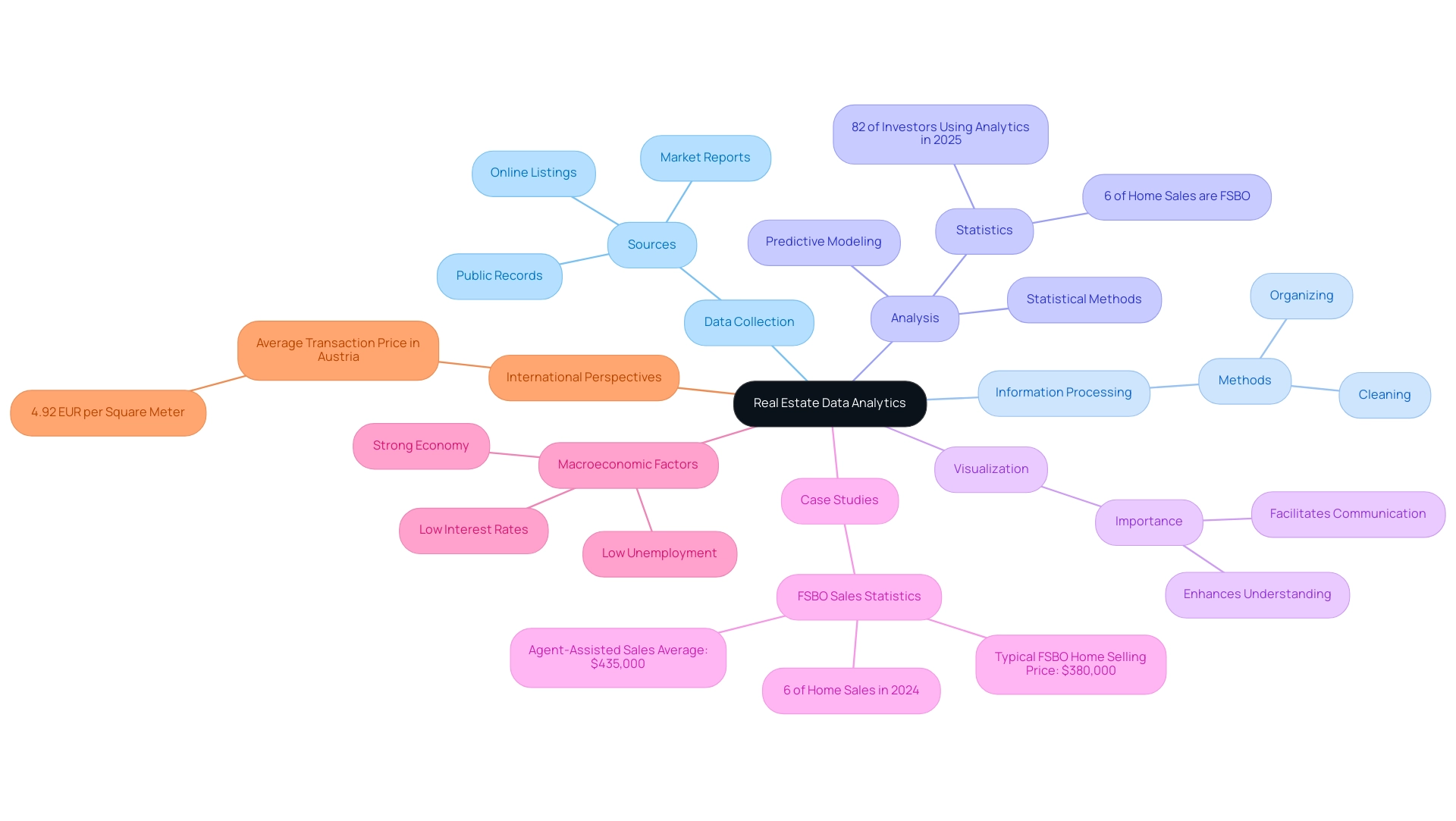
Key Tools and Technologies in Real Estate Data Analytics
Investors can significantly enhance their capabilities in real estate data analytics by leveraging a variety of advanced tools and technologies. Among the most popular options in 2025 are:
- Tableau: Renowned for its powerful data visualization capabilities, Tableau enables investors to create interactive and shareable dashboards that facilitate deeper insights into market trends and property performance.
- Microsoft Excel: A staple in information analysis, Excel provides strong functionalities for statistical evaluation and financial modeling, making it an essential tool for real estate professionals aiming to crunch numbers and predict potential returns.
- R and Python: These programming languages are invaluable for advanced information manipulation and predictive modeling. With extensive libraries dedicated to statistical analysis and machine learning, they empower individuals to conduct sophisticated analyses that can uncover hidden opportunities.
- GIS Software: Geographic Information Systems (GIS) tools are essential for analyzing spatial information. They enable stakeholders to evaluate location-based factors that significantly influence property values, such as proximity to amenities and demographic trends.
- Real Estate Analytics Platforms: Specialized platforms such as CoStar and Zillow offer extensive information on property listings, trends, and demographic insights, equipping stakeholders with the knowledge required to make informed choices.
Utilizing these tools streamlines the analysis process and leads to more informed and strategic investment decisions. For instance, free property valuation tools provided by certain realty groups, such as HomeLink, enable individuals to quickly access estimates and comparative data, enhancing their understanding of the market landscape. These tools empower investors to gain insights into comparable properties, which is crucial for making sound investment choices.
As the real property sector increasingly embraces real estate data analytics, the integration of these tools will be pivotal in navigating the complexities of investment opportunities. Significantly, the real property analytics sector is anticipated to expand considerably, with AI in Real Property expected to hit $1803.45 billion by 2030, increasing at a CAGR of 35%. Moreover, platforms such as Immobiliare.
Insights offer comprehensive information on the Italian and Greek property markets, presenting detailed KPIs and historical market coverage, which can be especially advantageous for individuals concentrating on those areas. With more than 30,000 subscribers, Zero Flux serves as a reliable source of property insights, assisting individuals in staying informed and making data-driven choices.
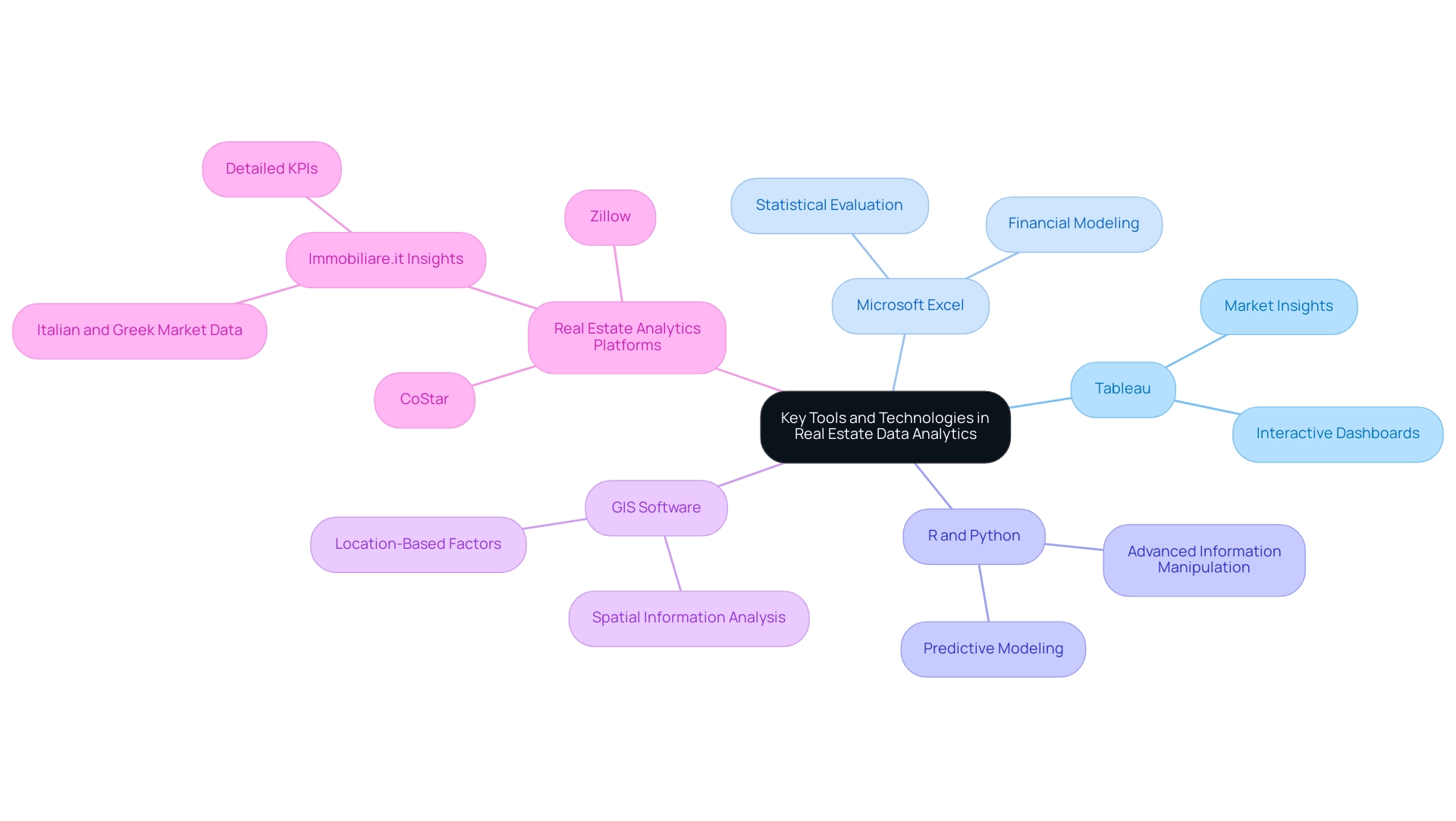
Benefits of Data Analytics in Real Estate Investment
Utilizing data analytics in real estate investment presents a multitude of advantages that significantly enhance decision-making processes.
-
Enhanced Decision-Making: Data-driven insights empower investors to make informed choices grounded in factual evidence rather than speculation. This approach minimizes uncertainty and fosters confidence in investment strategies.
-
Risk Mitigation: By meticulously analyzing trends and property performance, investors can pinpoint potential risks and adapt their strategies proactively. This analytical foresight is crucial in navigating the volatile nature of sectors through real estate data analytics.
-
Improved Property Valuation: Real estate data analytics facilitates more precise property valuations by incorporating a variety of factors, including location, current market conditions, and historical performance metrics. As Carey Wodehouse noted, "by reducing the time needed to perform property valuations, analytics can help to accelerate transactions." This comprehensive analysis, powered by real estate data analytics, leads to more accurate assessments, which are vital for making sound investment decisions.
Investors can leverage granular data on geographical, social, and economic factors to identify and engage specific demographics, optimizing their marketing efforts. This targeted approach not only enhances outreach but also increases conversion rates, making marketing campaigns more effective.
- Predictive Insights: Real estate data analytics tools can anticipate future industry trends, equipping stakeholders with the knowledge to stay ahead of the competition. By capitalizing on emerging opportunities, individuals can position themselves strategically within the market.
These advantages collectively enable investors to navigate the complexities of the real property landscape more effectively using real estate data analytics, ultimately leading to more successful investment outcomes. For instance, case studies have shown that analytics enables realtors and clients to conduct advanced searches based on specific criteria, as highlighted in the case study titled 'Advanced Search Capabilities for Customers.' This capability enhances the decision-making process by allowing for a deeper understanding of properties and their surrounding amenities.
Additionally, Zero Flux compiles 5-12 handpicked real property insights daily, showcasing the tangible impact of real estate data analytics on property investment.

The Impact of Big Data on Real Estate Investment Strategies
Large information sets have fundamentally transformed the real estate investment landscape, enabling advanced real estate data analytics that provide unparalleled access to vast knowledge influencing decision-making processes. Its impact is particularly evident in Market Analysis: Investors can leverage extensive datasets and real estate data analytics to uncover trends and patterns that inform their investment strategies. By utilizing historical valuation information and search query trends, they can time their purchases effectively and identify emerging opportunities.
Significantly, the Zero Flux newsletter curates 5-12 selected real property insights daily, offering investors a wealth of information to guide their choices.
- Consumer Behavior Insights: Analyzing data on buyer preferences and actions empowers investors to tailor their offerings to meet current demands. As highlighted by industry specialist 'Different', employing a mix of internal and external real estate information enables agencies to gain a precise view of their performance within a contextual framework. This approach not only enhances customer satisfaction but also drives sales by addressing the specific needs of target demographics.
- Enhanced Risk Assessment: Comprehensive information facilitates thorough risk evaluations by integrating various elements, including economic indicators and demographic shifts. This holistic perspective allows stakeholders to better understand potential fluctuations in the economy and make informed choices that mitigate risks. However, leveraging real estate data analytics in the sector can be challenging due to the necessity for high-quality information and the complexities of integrating and scaling collection operations.
- Operational Efficiency: The automation of data collection and advanced analytics streamlines processes, significantly reducing the time and resources required for comprehensive analysis. This efficiency enables stakeholders to focus on strategic initiatives rather than becoming overwhelmed by information management.
- Competitive Advantage: Those who effectively harness big information gain insights that competitors may overlook, positioning themselves for success in a competitive environment. As illustrated in the case study titled 'The Role of Information in Real Estate Investment Strategies', real estate data analytics is revolutionizing how stakeholders comprehend and engage with the industry. Individuals who incorporate sophisticated analytical techniques into their investment approaches can adeptly manage economic fluctuations and uncover growth opportunities within their portfolios.
As the real property sector continues to evolve, adopting extensive information will be crucial for those aiming to maintain a competitive edge. By 2025, a significant portion of participants is expected to utilize extensive information for market evaluation, underscoring its growing importance in shaping investment strategies. By remaining proactive and leveraging data-driven insights, individuals can enhance their decision-making processes and foster sustainable growth in their property ventures.
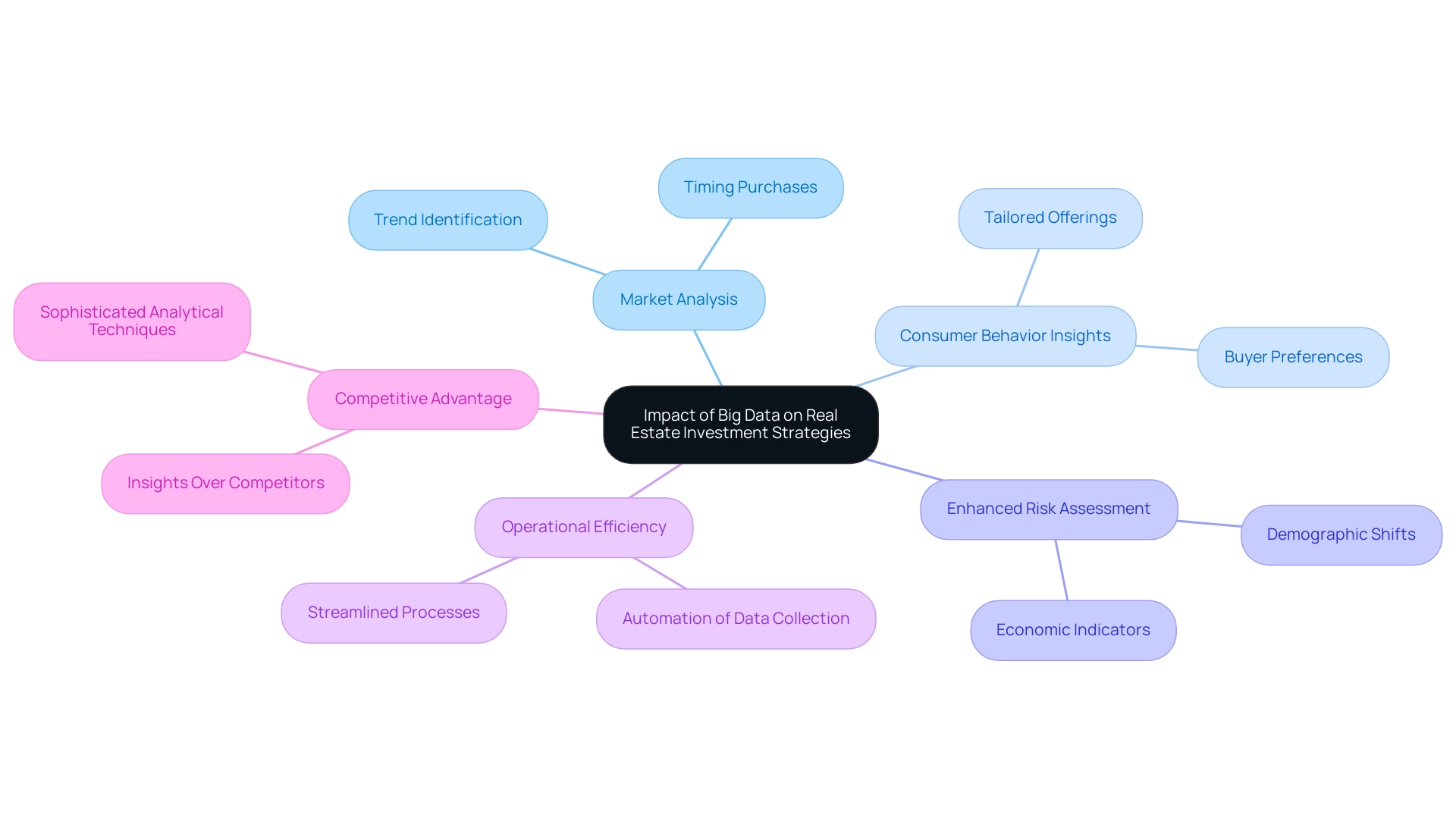
Challenges in Implementing Data Analytics for Real Estate Investments
While data analytics presents substantial benefits for real estate investors, several challenges can impede effective implementation.
-
Data Quality and Integrity: The accuracy and reliability of data are paramount for successful analysis. In 2025, issues surrounding information quality remain prevalent. Poor information can lead to misguided investment decisions, ultimately affecting profitability. As Derek Wood aptly states, "Insights offer a glimpse of the future and equip professionals with relevant information to take proactive measures and avoid pitfalls."
-
Integration of Diverse Information Sources: The consolidation and analysis process is complicated by the need for real estate data analytics, as real estate information is often sourced from a multitude of platforms. This fragmentation can hinder the ability to derive actionable insights from the information.
-
Skill Gaps: A significant barrier for many individuals is the lack of necessary analytical skills. This gap necessitates either extensive training for existing staff or the hiring of specialized professionals, which can be resource-intensive.
-
Cost of Technology: The financial investment required for advanced analytics tools can be prohibitive, particularly for smaller stakeholders. The costs associated with acquiring and maintaining these technologies can deter potential adopters.
-
Resistance to Change: A cultural reluctance to embrace data-driven methodologies persists among some stakeholders, who may prefer traditional decision-making processes. This resistance can slow the adoption of innovative practices that utilize analytics.
Recognizing these challenges allows investors to proactively devise strategies using real estate data analytics to mitigate them. For example, utilizing advanced Privacy Enhancing Technologies (Pets) can guarantee that real property information remains secure, even when processed externally. Furthermore, case studies demonstrate how analytics can revolutionize marketing and tenant acquisition by focusing on the appropriate audience through foot traffic and demographic assessment, ultimately redefining the future of realty marketing.
This targeted approach improves the chances of closing deals and supports the creation of a tenant mix that drives profitability. By addressing these hurdles, individuals can facilitate a smoother transition to data-driven investment practices through real estate data analytics, enhancing their decision-making capabilities and positioning themselves for success in a competitive market. Moreover, remaining updated on analytics trends is essential, as demonstrated by the newsletter's daily selection of 5-12 curated realty insights, which acts as an important resource for industry experts.
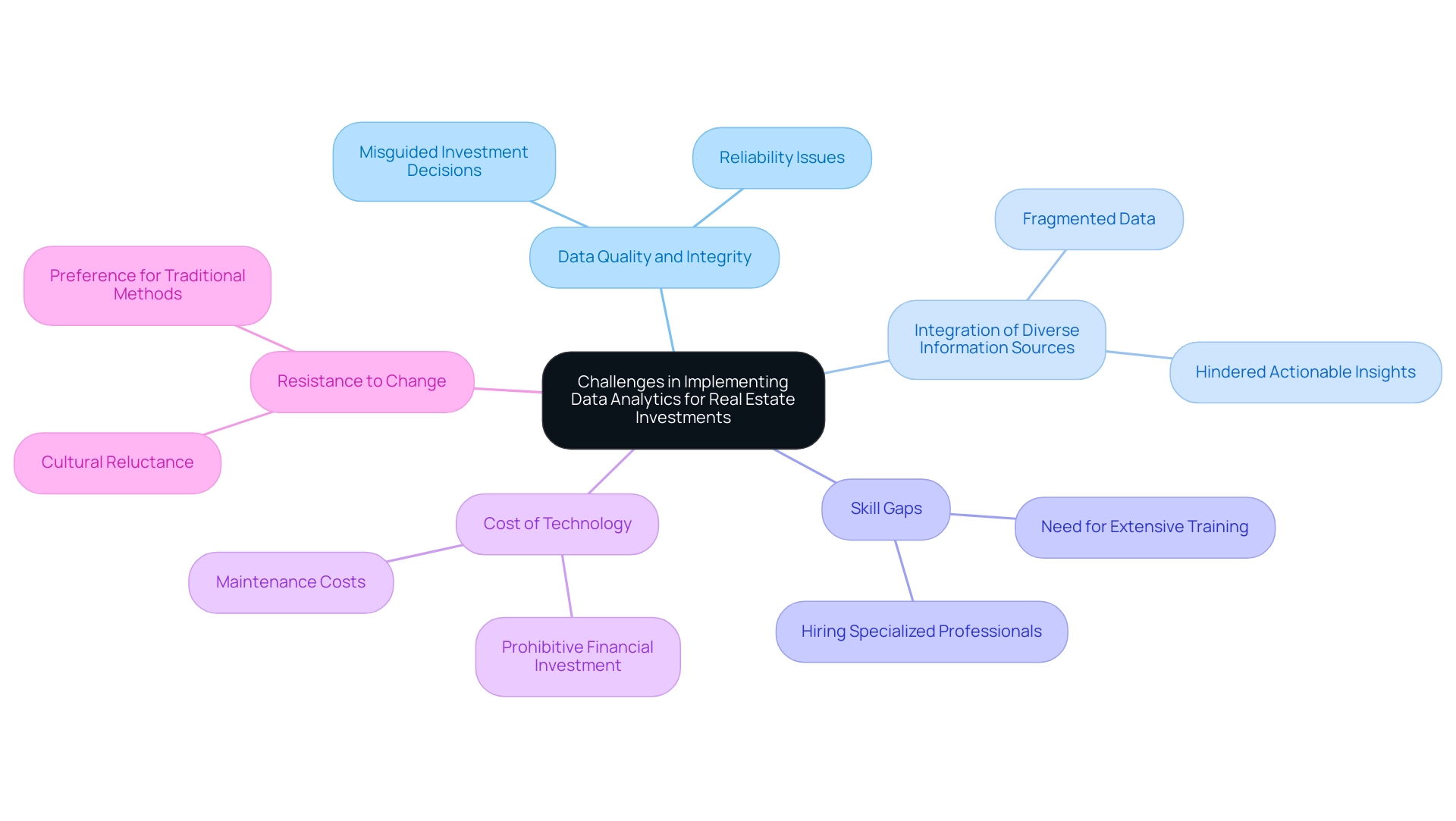
Case Studies: Successful Data-Driven Investment Decisions
Property investors are progressively utilizing real estate data analytics to enhance their investment approaches. Several compelling case studies illustrate this trend:
-
Case Study 1: Predictive Analytics in Action: A prominent real property investment firm successfully employed predictive analytics to pinpoint emerging neighborhoods. By examining demographic trends alongside historical sales information, they strategically invested in properties that appreciated significantly over a five-year period, achieving an impressive 30% return on investment.
-
Case Study 2: Risk Reduction through Information: A commercial realty company adopted a data-driven risk evaluation model integrating various economic indicators with local conditions. This proactive strategy allowed them to avoid investments in sectors with diminishing economic outlooks, effectively protecting their portfolio from potential losses.
-
Case Study 3: Targeted Marketing Success: A residential developer utilized analytics to gain insights into buyer preferences within a particular segment. By customizing their marketing approaches according to these analytical insights, they experienced a 25% rise in their sales conversion rate within just one year.
These case studies highlight the practical benefits of incorporating real estate data analytics into investment choices. By making informed decisions based on real estate data analytics, individuals can unlock significant financial benefits and navigate the complexities of the environment with increased confidence.
As Mark Fleming, Chief Economist at First American Financial Corporation, observes, 'If the 2020-2021 housing sector was too hot, then the 2023 sector was likely too cold, but 2024 won’t yet be just right.' This viewpoint emphasizes the importance of understanding economic dynamics when making financial choices.
Additionally, CoStar Group offers real estate data analytics on millions of properties across international economies, supplying stakeholders with a wealth of data to guide their strategies. The combination of augmented reality (AR) and virtual reality (VR) technologies is also enhancing the buyer experience, enabling remote property exploration and informed decision-making.
In light of the surging demand for affordable housing, public-private partnerships are emerging as significant opportunities for stakeholders, offering substantial returns and social benefits. Industry leaders emphasize the importance of long-term strategies over market timing, reinforcing the value of real estate data analytics in navigating the real property landscape in 2025.
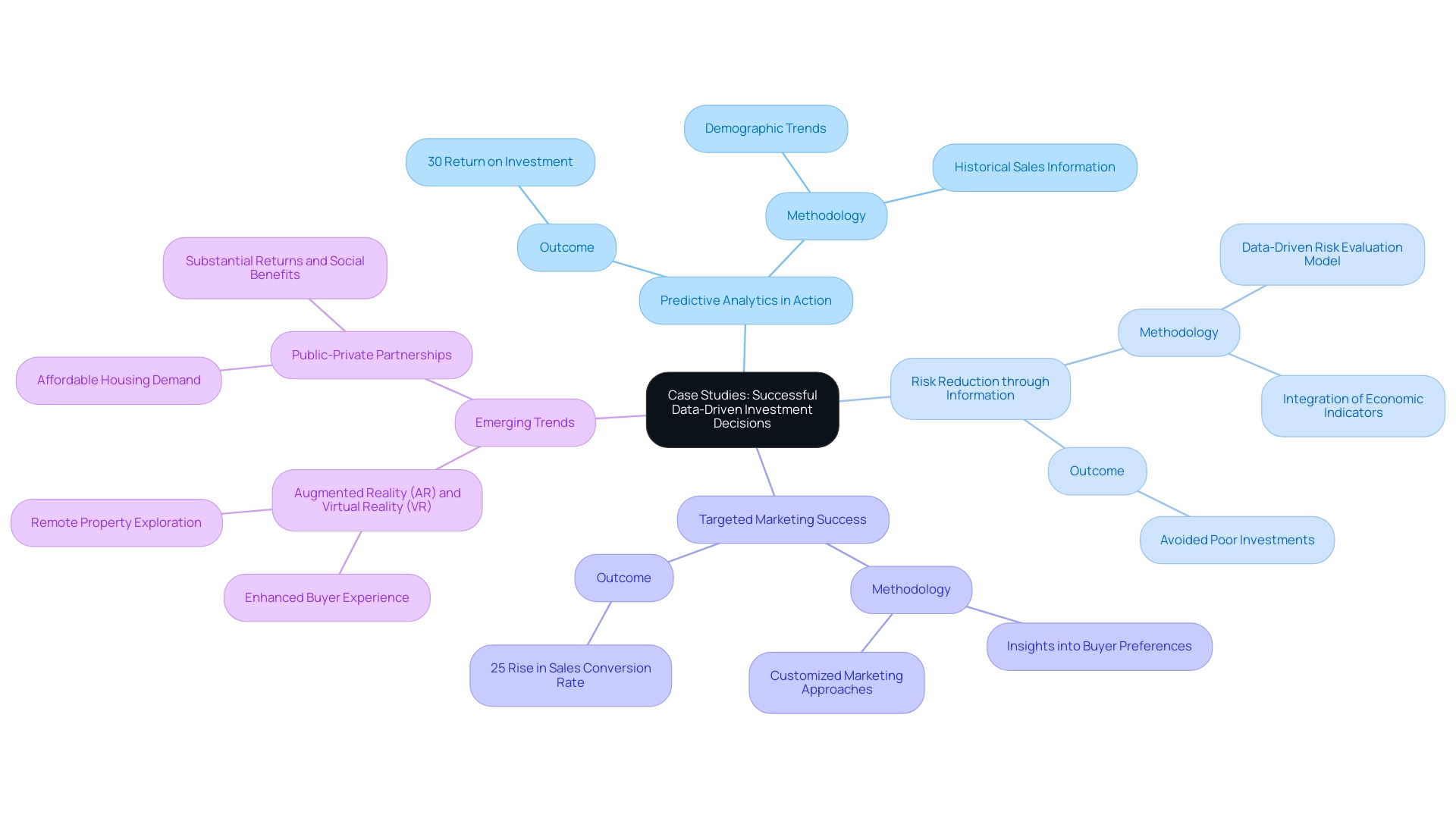
Future Trends in Real Estate Data Analytics and Investment
As technology continues to advance, several key trends are set to reshape the landscape of real property analytics in 2025:
- Increased Use of AI and Machine Learning: These sophisticated technologies are poised to transform predictive analytics, enabling stakeholders to create more accurate forecasts and actionable insights. By harnessing vast datasets, AI and machine learning enhance decision-making processes through real estate data analytics by identifying patterns that human analysts might overlook. Notably, high-net-worth purchasers are increasingly pursuing residences featuring advanced automation, including AI security systems, indicating a rising trend towards technology-driven investments.
- Integration of IoT Information: The Internet of Things (IoT) will play a crucial role in providing real-time information from properties. This surge of information, particularly in real estate data analytics, will empower stakeholders to make knowledgeable choices based on present circumstances, such as occupancy rates and maintenance requirements, ultimately resulting in more strategic investments.
- Greater Emphasis on Privacy: With the rising amount of information gathering, adherence to privacy regulations will become crucial for real estate companies. Investors must prioritize information integrity and security to build trust and protect sensitive details. Zero Flux exemplifies this commitment to data integrity by utilizing real estate data analytics to source information from a wide array of credible outlets, ensuring that its subscribers receive reliable insights.
- Expansion of Data Sources: The emergence of new data sources, including social media insights and consumer behavior analytics, will enrich the information landscape available to stakeholders. This diversification will allow for a more nuanced understanding of market dynamics and consumer preferences using real estate data analytics. Furthermore, younger buyers are exploring co-living spaces as a cost-effective alternative to traditional homeownership, reflecting changing family structures and housing needs.
- Focus on Sustainability Metrics: As environmental concerns gain traction, stakeholders will increasingly incorporate sustainability factors into their analyses. This shift aligns with the growing consumer demand for environmentally responsible practices, making it essential for stakeholders to evaluate properties based on their sustainability credentials.
- Economic Factors: Current economic news indicates that several proposals could lead to rising inflation, potentially resulting in higher mortgage rates that would further dampen housing demand. Investors must stay informed about these economic factors to navigate the complexities of the real estate sector effectively.
By staying informed about these trends, investors can capitalize on emerging opportunities and maintain a competitive advantage in the rapidly evolving real estate field. The integration of AI and machine learning, in particular, is expected to reshape investment strategies, as evidenced by the rising interest among high-net-worth buyers in properties equipped with sophisticated automation, AI security systems, and real estate data analytics. As the market adapts to these advancements, understanding their implications will be crucial for making smarter investment decisions.
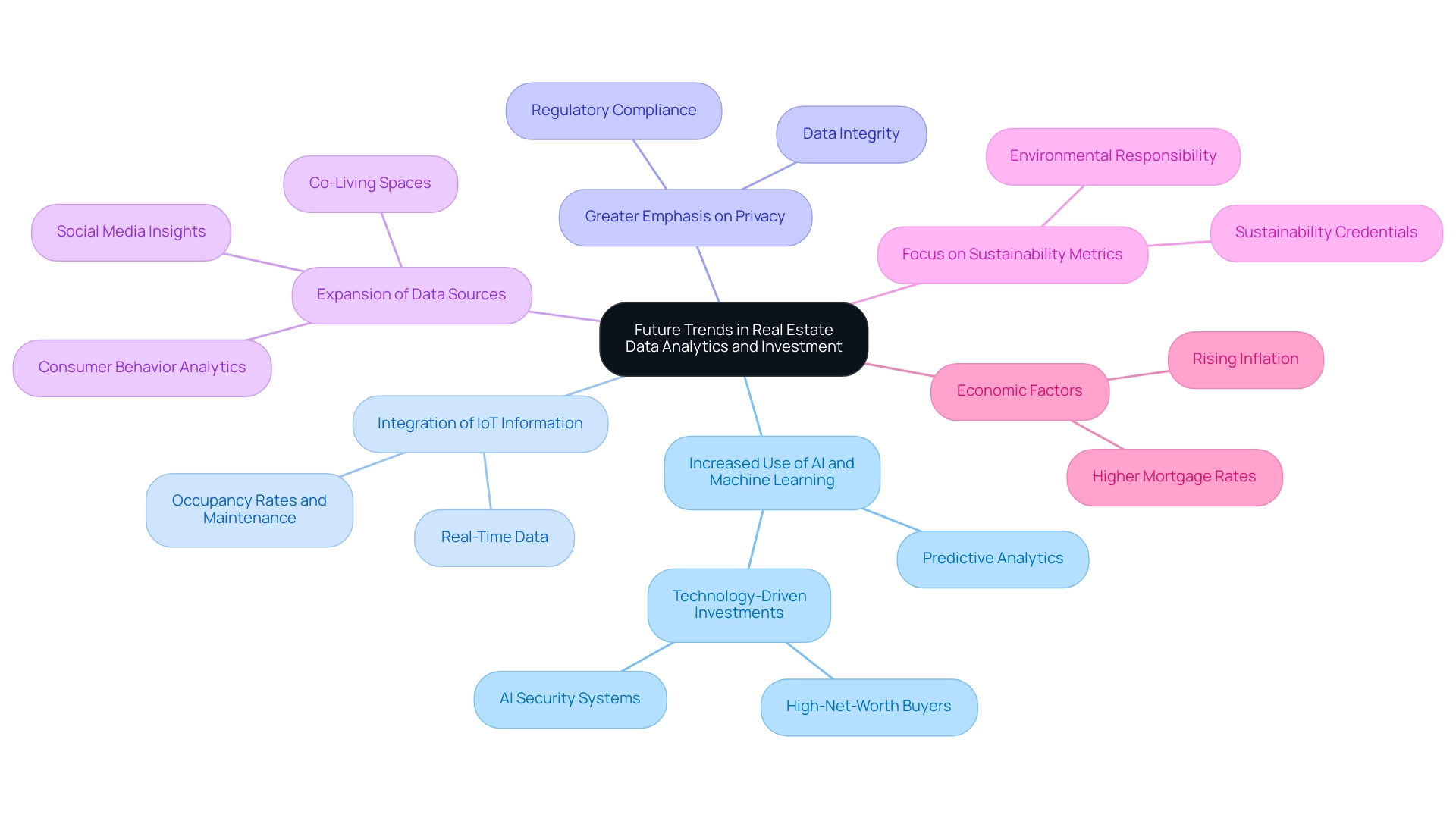
Conclusion
Data analytics has firmly established itself as a cornerstone of modern real estate investment, providing a wealth of insights that empower investors to make informed decisions. By systematically collecting and analyzing data, investors can navigate market complexities with greater confidence, identifying trends and uncovering lucrative opportunities. The critical components of data analytics—data collection, processing, analysis, and visualization—are essential for deriving actionable insights that enhance investment strategies.
The integration of advanced tools and technologies, including AI, machine learning, and GIS software, amplifies the potential of data analytics. These innovations not only improve decision-making processes but also facilitate risk mitigation and targeted marketing strategies. As demonstrated through various case studies, investors who harness the power of data analytics can achieve significant financial gains while effectively managing risks associated with market fluctuations.
However, challenges such as data quality, integration, and the need for specialized skills must be addressed to fully realize the benefits of data analytics. By overcoming these hurdles, investors can position themselves for success in an increasingly competitive landscape. As the real estate market continues to evolve, staying abreast of emerging trends and technologies will be crucial for maintaining a competitive edge. Ultimately, the strategic use of data analytics will enhance investment outcomes and redefine the future of real estate investment strategies.

